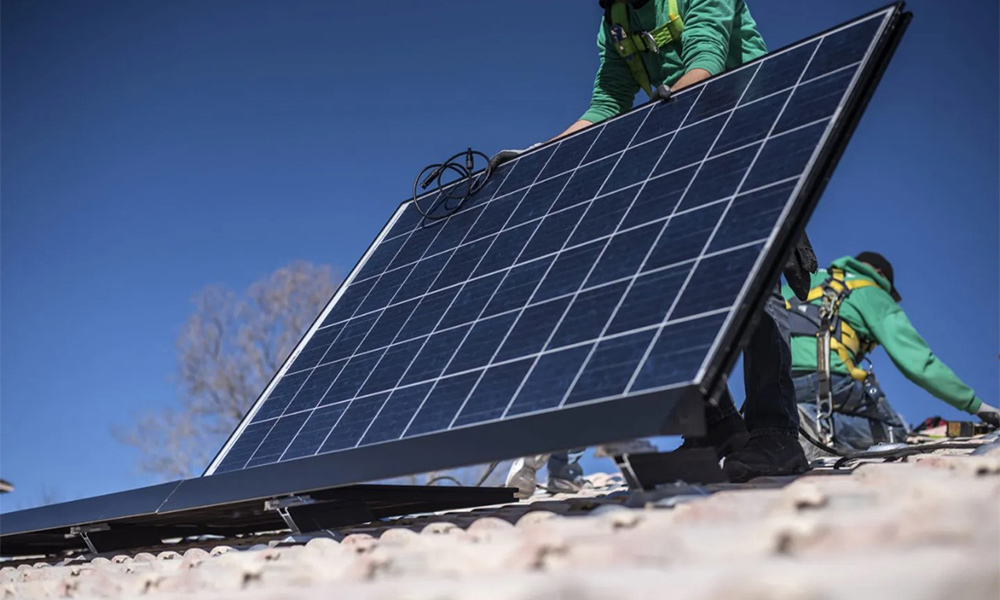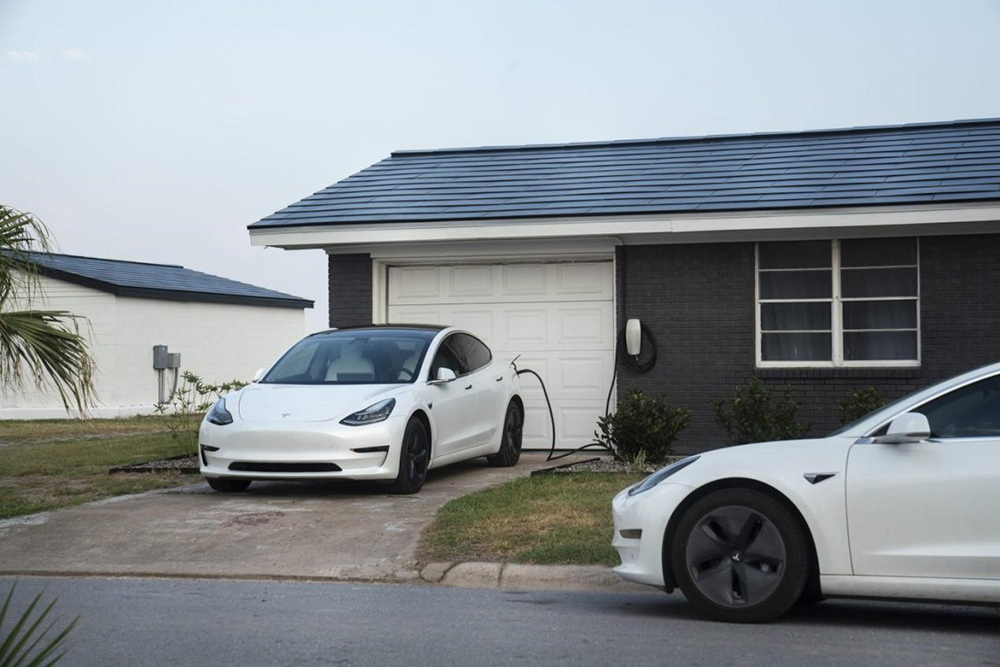马斯克的太阳能野心破灭

对于一个热衷于大张旗鼓宣传的企业家来说,很难想象还有比特斯拉位于纽约州北部的超级工厂2号更荒凉的地方了。特斯拉从纳税人手中租用的这个占地120万平方英尺(11万平方米)的综合设施,建在一家钢铁厂的旧址上,本应是整个西半球同类设施中最大的,一旦完全建成,每年可生产1000兆瓦的太阳能屋顶和电池板。届时,庞大的RiverBend厂址将成为其他企业家的灯塔,为该地区带来更多的先进制造业工作岗位。
大约七年后,这里依然灯火通明,但只是勉强亮着。据伍德麦肯兹公司(Wood Mackenzie)估计,自特斯拉太阳能屋顶这一产品推出以来,其在美国的总安装量最近才达到3,000个,发电量甚至不到区区30兆瓦时。供参考,马斯克的目标是每周安装1000个太阳能屋顶。虽然太阳能市场在不断增长,但所有特斯拉太阳能产品的部署量在过去一年中仅勉强增长了1%,部署容量为348兆瓦,而且到2023年为止,正朝着每年下降近三分之一的方向发展。其大部分业务仍然是销售传统的光伏太阳能电池板,缺乏独特的卖点或先发优势。
代表布法罗地区的州参议员肖恩·瑞安(Sean Ryan)表示,特斯拉位于纽约州北部的超级工厂2号的太阳能屋顶和标准电池板产量目前仍然很低,以至于特斯拉不得不雇用低级别的信息技术分析师为自动驾驶汽车输入数据,以达到就业指标(获得州政府援助设定的条件)。

该工厂需要创造约1,500个工作岗位,否则特斯拉将面临数千万美元的罚款。瑞安告诉《财富》杂志:“在大规模支持下,他们一瘸一拐地冲过了终点线。”(特斯拉没有回应置评请求。)
这些美观耐用的瓦片于2016年亮相,由经过特殊处理的钢化玻璃制成,既可以用作屋顶板,也可以用作太阳能电池。它们可以抵御高尔夫球大小的冰雹的冲击,在需要时可以轻松扣入扣出,方便更换,并提供25年的保修期。与特斯拉Powerwall家用电池储能系统搭配使用,房主对这些产品产生和储存的所有能源赞叹不已(使用该公司的智能手机应用程序)。简而言之,这是能源独立型家庭的终极早期产品。
事实上,特斯拉太阳能屋顶很可能会成为马斯克最没有被大肆宣传的产品,而且他似乎对销售这款产品兴趣不大。
三位一体的清洁能源
七年前,特斯拉公司斥资26亿美元收购了由马斯克的两位表兄弟林登·里夫(Lyndon)和彼得·里夫(Peter Rive)创办的SolarCity,同时,特斯拉太阳能屋顶亮相。当时,SolarCity是美国市场的领导者,2016年的装机量刚刚超过800兆瓦,是特斯拉去年装机量的两倍多。然而,这笔交易却饱受争议。面对"严重的流动性危机",SolarCity在2015年底陷入困境,并面临违反贷款契约的风险。由阿肯色州教师养老基金牵头的集体诉讼称,马斯克作为两家公司的最大股东,拥有约五分之一的有表决权的股票,可以直接从收购中获利,并利用自己的影响力迫使特斯拉董事会施以紧急救助。虽然董事们达成了庭外和解,但马斯克不认可索赔方案,并于去年在特拉华州衡平法院胜诉。后来,州最高法院维持了这一裁决。
如今,SolarCity的资产被并入了特斯拉,在特斯拉的能源生产和储存部门中只占很小一部分,由马斯克三大副手中任职时间最长的德鲁·巴格利诺(Drew Baglino)负责。这位特斯拉高级副总裁的当务之急是提高下一代4680电池的性能,并为马斯克的核心汽车业务部门扩大生产规模;在巴格利诺的待办事项清单上,解决太阳能问题可能排在很靠后的位置。特斯拉的12.8万名员工中有多少人为太阳能业务工作,这谁也说不准,因为该公司只公布季度部署数据,以便让投资者了解进展情况。然而,这很有可能只是舍入误差。

从理论上讲,太阳能完善了马斯克清洁能源产品的良性循环——特斯拉用户拥有一辆电动汽车,将汽车插入家用电池充电,然后用温暖富足的太阳光为所有产品供电,这就是三位一体模式。
KPost的杰恩斯(Jaynes)证实:“我们不会向那些还没有电动汽车的人大量销售特斯拉太阳能屋顶。他们往往已经加入了这一行列,正在考虑如何进入下一个阶段。”
马斯克经常预测,其价值39亿美元的能源业务最终将在规模和盈利能力上与规模大得多的汽车业务相媲美。去年,汽车业务的营收达到670亿美元,毛利率高达20%。然而,据未来基金(Future Fund)联合创始人兼执行合伙人、一直看好特斯拉的知名投资者加里·布莱克(Gary Black)称,尽管特斯拉的Megapack商用储能电池业务表现超出了投资者的预期,但太阳能业务仍然如此微不足道,以至于大多数投资者甚至没有费力尝试对其业绩进行建模。他说:“太阳能是可持续发展的下一个前沿领域,这是因为你可以用太阳能屋顶为汽车充电。但这是一项艰巨得多的业务,因为大部分工作都涉及安装。与特斯拉在电动汽车领域拥有先发优势相比,要在这一领域脱颖而出更难。”
太阳能市场正在升温
得益于30%的联邦所得税抵免、不断飙升的能源价格,以及向公用事业公司出售多余电力的高额上网电价,美国住宅太阳能市场在2022年连续第六年创下历史新高,约70万户家庭安装了光伏屋顶,总计相当于6000兆瓦——根据伍德麦肯兹公司和美国太阳能产业协会(Solar Energy Industries Association)的数据,其产能每年增加40%。更重要的是,需求强劲的不仅仅是美国。国际能源署(International Energy Agency)认为,到2027年,太阳能光伏发电将超过煤炭,成为世界上最大的发电来源,因为在过去10年里,太阳能光伏发电的成本下降了80%以上。
一些批评人士(和竞争对手)认为,马斯克在试图将特斯拉的蓝图用于SolarCity时失算了,因为他还没有意识到这两项业务有多么不同。
Svea Solar的联合创始人埃里克·马丁森(Erik Martinson)表示:“如果你想一下,与特斯拉流线型汽车业务的集中式生产线相反的是,它将提供定制的太阳能屋顶,你必须将所有东西都精确到一英寸,才能完美契合。没有任何协同效应。”
这位土生土长的瑞典人兼特斯拉Model 3用户在圣地亚哥生活期间受到了马斯克的启发,他说自己曾五次申请为这家汽车制造商工作,但每次都遭到了拒绝。
相反,马丁森联合创立了他自己的太阳能公司,并声称其公司已经超过了他的榜样目前每季度60兆瓦太阳能光伏发电量的平均运行率。他说:“今年,我们每季度的发电量约为75兆瓦,但我们的发展速度相当快,明年我们将把发电量增加到100兆瓦以上。”在他看来,如果特斯拉是一家独立的公司,其太阳能业务很可能会增长得更快。
马斯克已经意识到,与今年推出的100多万辆几乎一模一样的Model Y汽车不同,安装太阳能电池以满足每种需求需要每次都重新发明车轮。马斯克在2021年4月承认:“在评估某些屋顶的难度时,我们基本上犯了一些重大错误。”他选择尝试标准化方法,以便在未来,每个客户的房子“在电气上看起来都一样,而不是一件独特的艺术品。”
即使在像德克萨斯州这样电网不稳定、不可靠的地方,说服房主勇敢尝试太阳能也并非易事。这在很大程度上与太阳能屋顶的溢价有关,平均10千瓦电池阵列的太阳能屋顶(包括固定电池)的价格轻轻松松就能达到5万美元。杰恩斯说,有太多的德克萨斯人每隔几年就搬一次家,这样的投资难以获得回报。考虑到马斯克对广告持极端怀疑态度,因此宣传工作非常困难。他最近一次大张旗鼓地宣传来吸引媒体关注还要追溯到2016年10月,当时他首次展示了太阳能屋顶,就在特斯拉股东就其收购SolarCity进行投票的几周之前。
近年来,股东们似乎对他在人工智能、自动驾驶汽车和两条腿的擎天柱机器人方面的努力更加感兴趣。相比之下,马斯克的第三个总体规划(其中包括推广更多太阳能项目)在3月份的投资者日上铩羽而归。工匠们爬上屋顶安装太阳能电池板,如何能与机器人管家的最终前景竞争?在特斯拉2023年的三次季度财报电话会议中,巴格利诺只有一次提及太阳能业务。随着销量朝着错误的方向发展,马斯克本人也没什么兴趣,完全避免了这个问题,这也是可以理解的。
回到纽约州北部,超级工厂2号仍在勉强运转。特斯拉在该项目的工业合作伙伴松下(Panasonic)已经撤出了该工厂,在此过程中裁减了数百个工作岗位。州政府纳税人购买的价值约2亿美元的机器已被出售或直接报废。
瑞安说:"该厂址的复兴具有深刻的象征意义。我们对这个项目寄予厚望,并投入了大量的经济发展资金,但却事与愿违。现在我们感到灰心丧气。”(财富中文网)
译者:中慧言-王芳
对于一个热衷于大张旗鼓宣传的企业家来说,很难想象还有比特斯拉位于纽约州北部的超级工厂2号更荒凉的地方了。特斯拉从纳税人手中租用的这个占地120万平方英尺(11万平方米)的综合设施,建在一家钢铁厂的旧址上,本应是整个西半球同类设施中最大的,一旦完全建成,每年可生产1000兆瓦的太阳能屋顶和电池板。届时,庞大的RiverBend厂址将成为其他企业家的灯塔,为该地区带来更多的先进制造业工作岗位。
大约七年后,这里依然灯火通明,但只是勉强亮着。据伍德麦肯兹公司(Wood Mackenzie)估计,自特斯拉太阳能屋顶这一产品推出以来,其在美国的总安装量最近才达到3,000个,发电量甚至不到区区30兆瓦时。供参考,马斯克的目标是每周安装1000个太阳能屋顶。虽然太阳能市场在不断增长,但所有特斯拉太阳能产品的部署量在过去一年中仅勉强增长了1%,部署容量为348兆瓦,而且到2023年为止,正朝着每年下降近三分之一的方向发展。其大部分业务仍然是销售传统的光伏太阳能电池板,缺乏独特的卖点或先发优势。
代表布法罗地区的州参议员肖恩·瑞安(Sean Ryan)表示,特斯拉位于纽约州北部的超级工厂2号的太阳能屋顶和标准电池板产量目前仍然很低,以至于特斯拉不得不雇用低级别的信息技术分析师为自动驾驶汽车输入数据,以达到就业指标(获得州政府援助设定的条件)。
动力循环:马斯克设想了特斯拉的三位一体模式,即电动汽车由电池充电,而电池又由公司的太阳能电池板供电。
该工厂需要创造约1,500个工作岗位,否则特斯拉将面临数千万美元的罚款。瑞安告诉《财富》杂志:“在大规模支持下,他们一瘸一拐地冲过了终点线。”(特斯拉没有回应置评请求。)
这些美观耐用的瓦片于2016年亮相,由经过特殊处理的钢化玻璃制成,既可以用作屋顶板,也可以用作太阳能电池。它们可以抵御高尔夫球大小的冰雹的冲击,在需要时可以轻松扣入扣出,方便更换,并提供25年的保修期。与特斯拉Powerwall家用电池储能系统搭配使用,房主对这些产品产生和储存的所有能源赞叹不已(使用该公司的智能手机应用程序)。简而言之,这是能源独立型家庭的终极早期产品。
事实上,特斯拉太阳能屋顶很可能会成为马斯克最没有被大肆宣传的产品,而且他似乎对销售这款产品兴趣不大。
三位一体的清洁能源
七年前,特斯拉公司斥资26亿美元收购了由马斯克的两位表兄弟林登·里夫(Lyndon)和彼得·里夫(Peter Rive)创办的SolarCity,同时,特斯拉太阳能屋顶亮相。当时,SolarCity是美国市场的领导者,2016年的装机量刚刚超过800兆瓦,是特斯拉去年装机量的两倍多。然而,这笔交易却饱受争议。面对"严重的流动性危机",SolarCity在2015年底陷入困境,并面临违反贷款契约的风险。由阿肯色州教师养老基金牵头的集体诉讼称,马斯克作为两家公司的最大股东,拥有约五分之一的有表决权的股票,可以直接从收购中获利,并利用自己的影响力迫使特斯拉董事会施以紧急救助。虽然董事们达成了庭外和解,但马斯克不认可索赔方案,并于去年在特拉华州衡平法院胜诉。后来,州最高法院维持了这一裁决。
如今,SolarCity的资产被并入了特斯拉,在特斯拉的能源生产和储存部门中只占很小一部分,由马斯克三大副手中任职时间最长的德鲁·巴格利诺(Drew Baglino)负责。这位特斯拉高级副总裁的当务之急是提高下一代4680电池的性能,并为马斯克的核心汽车业务部门扩大生产规模;在巴格利诺的待办事项清单上,解决太阳能问题可能排在很靠后的位置。特斯拉的12.8万名员工中有多少人为太阳能业务工作,这谁也说不准,因为该公司只公布季度部署数据,以便让投资者了解进展情况。然而,这很有可能只是舍入误差。
硬电池:房主们对特斯拉的太阳能屋顶赞不绝口,但每次安装费用约为5万美元,因此尚未得到广泛应用。
从理论上讲,太阳能完善了马斯克清洁能源产品的良性循环——特斯拉用户拥有一辆电动汽车,将汽车插入家用电池充电,然后用温暖富足的太阳光为所有产品供电,这就是三位一体模式。
KPost的杰恩斯(Jaynes)证实:“我们不会向那些还没有电动汽车的人大量销售特斯拉太阳能屋顶。他们往往已经加入了这一行列,正在考虑如何进入下一个阶段。”
马斯克经常预测,其价值39亿美元的能源业务最终将在规模和盈利能力上与规模大得多的汽车业务相媲美。去年,汽车业务的营收达到670亿美元,毛利率高达20%。然而,据未来基金(Future Fund)联合创始人兼执行合伙人、一直看好特斯拉的知名投资者加里·布莱克(Gary Black)称,尽管特斯拉的Megapack商用储能电池业务表现超出了投资者的预期,但太阳能业务仍然如此微不足道,以至于大多数投资者甚至没有费力尝试对其业绩进行建模。他说:“太阳能是可持续发展的下一个前沿领域,这是因为你可以用太阳能屋顶为汽车充电。但这是一项艰巨得多的业务,因为大部分工作都涉及安装。与特斯拉在电动汽车领域拥有先发优势相比,要在这一领域脱颖而出更难。”
太阳能市场正在升温
得益于30%的联邦所得税抵免、不断飙升的能源价格,以及向公用事业公司出售多余电力的高额上网电价,美国住宅太阳能市场在2022年连续第六年创下历史新高,约70万户家庭安装了光伏屋顶,总计相当于6000兆瓦——根据伍德麦肯兹公司和美国太阳能产业协会(Solar Energy Industries Association)的数据,其产能每年增加40%。更重要的是,需求强劲的不仅仅是美国。国际能源署(International Energy Agency)认为,到2027年,太阳能光伏发电将超过煤炭,成为世界上最大的发电来源,因为在过去10年里,太阳能光伏发电的成本下降了80%以上。
一些批评人士(和竞争对手)认为,马斯克在试图将特斯拉的蓝图用于SolarCity时失算了,因为他还没有意识到这两项业务有多么不同。
Svea Solar的联合创始人埃里克·马丁森(Erik Martinson)表示:“如果你想一下,与特斯拉流线型汽车业务的集中式生产线相反的是,它将提供定制的太阳能屋顶,你必须将所有东西都精确到一英寸,才能完美契合。没有任何协同效应。”
这位土生土长的瑞典人兼特斯拉Model 3用户在圣地亚哥生活期间受到了马斯克的启发,他说自己曾五次申请为这家汽车制造商工作,但每次都遭到了拒绝。
相反,马丁森联合创立了他自己的太阳能公司,并声称其公司已经超过了他的榜样目前每季度60兆瓦太阳能光伏发电量的平均运行率。他说:“今年,我们每季度的发电量约为75兆瓦,但我们的发展速度相当快,明年我们将把发电量增加到100兆瓦以上。”在他看来,如果特斯拉是一家独立的公司,其太阳能业务很可能会增长得更快。
马斯克已经意识到,与今年推出的100多万辆几乎一模一样的Model Y汽车不同,安装太阳能电池以满足每种需求需要每次都重新发明车轮。马斯克在2021年4月承认:“在评估某些屋顶的难度时,我们基本上犯了一些重大错误。”他选择尝试标准化方法,以便在未来,每个客户的房子“在电气上看起来都一样,而不是一件独特的艺术品。”
即使在像德克萨斯州这样电网不稳定、不可靠的地方,说服房主勇敢尝试太阳能也并非易事。这在很大程度上与太阳能屋顶的溢价有关,平均10千瓦电池阵列的太阳能屋顶(包括固定电池)的价格轻轻松松就能达到5万美元。杰恩斯说,有太多的德克萨斯人每隔几年就搬一次家,这样的投资难以获得回报。考虑到马斯克对广告持极端怀疑态度,因此宣传工作非常困难。他最近一次大张旗鼓地宣传来吸引媒体关注还要追溯到2016年10月,当时他首次展示了太阳能屋顶,就在特斯拉股东就其收购SolarCity进行投票的几周之前。
近年来,股东们似乎对他在人工智能、自动驾驶汽车和两条腿的擎天柱机器人方面的努力更加感兴趣。相比之下,马斯克的第三个总体规划(其中包括推广更多太阳能项目)在3月份的投资者日上铩羽而归。工匠们爬上屋顶安装太阳能电池板,如何能与机器人管家的最终前景竞争?在特斯拉2023年的三次季度财报电话会议中,巴格利诺只有一次提及太阳能业务。随着销量朝着错误的方向发展,马斯克本人也没什么兴趣,完全避免了这个问题,这也是可以理解的。
回到纽约州北部,超级工厂2号仍在勉强运转。特斯拉在该项目的工业合作伙伴松下(Panasonic)已经撤出了该工厂,在此过程中裁减了数百个工作岗位。州政府纳税人购买的价值约2亿美元的机器已被出售或直接报废。
瑞安说:"该厂址的复兴具有深刻的象征意义。我们对这个项目寄予厚望,并投入了大量的经济发展资金,但却事与愿违。现在我们感到灰心丧气。”(财富中文网)
译者:中慧言-王芳
For an entrepreneur who thrives on loud and splashy promotion, it’s hard to imagine a more forlorn spot than Tesla’s upstate New York “Gigafactory 2.” Built on the former grounds of a steel mill, the 1.2-million-square-foot complex, which Tesla leases from the taxpayer, was supposed to be the largest facility of its kind in the entire Western hemisphere, capable of producing 1,000 megawatts of solar roofs and panels annually once fully scaled. The massive RiverBend site would then serve as a beacon to other entrepreneurs, attracting more advanced manufacturing jobs to the area.
Some seven years later the lights are still on—but just barely. Wood Mackenzie estimated aggregate Tesla Solar Roof installations in the U.S. just recently hit 3,000 since the product launched—not even enough to produce a measly 30 megawatts of electricity in total. For context, Musk had aspired to a goal of installing 1,000 roofs per week. While the solar market grows, deployments of all Tesla solar products barely eked out a 1% increase in the past year, deploying 348 MW of capacity—and so far in 2023 it is tracking toward an annual decline of nearly a third. The bulk of its business remains selling conventional photovoltaic (PV) solar panels, where it lacks a unique selling point or first mover edge.
Solar Roof and standard panel production at its Gigafactory 2 in upstate New York now remains so low that Tesla had to hire low-level IT analysts inputting data for self-driving cars, says Sean Ryan, a state senator representing the Buffalo area, just to hit employment targets imposed as conditions for receiving state aid.
Around 1,500 jobs needed to be created at the site lest Tesla be subject to fines in the tens of millions of dollars. “They limped over the finish line and only with a lot of help,” Ryan tells Fortune. (Tesla did not respond to a request for comment.)
Unveiled in 2016, these elegant and durable tiles made from a specially treated tempered glass serve as both shingles and solar cells. They can withstand the impact of golf-ball-size hail, snap in and out for easy replacement if needed, and come with a 25-year warranty. Paired with a Tesla Powerwall residential battery, homeowners can marvel at all the energy they generate and store using the company’s smartphone app. In short, it’s the ultimate early adopter product for the energy-independent household.
Indeed, the Tesla Solar Roof may very well earn the distinction of being Musk’s most under-hyped product—as well as one he appears to have little interest in selling.
The holy trinity of clean energy
The unveiling of Tesla’s Solar Roof coincided precisely with the brand’s entry into the market seven years ago through the $2.6 billion acquisition of SolarCity, founded by two of Musk’s cousins, Lyndon and Peter Rive. At the time it was the U.S. market leader with just over 800 MW installed in 2016, more than twice what Tesla achieved last year. Yet controversy dogged the deal. Facing a “major liquidity crisis,” SolarCity was in dire straits by the end of 2015 and risked breaching loan covenants. A class action lawsuit led by Arkansas’s teachers pension fund argued that Musk, as the largest shareholder of both companies with roughly a fifth of the voting stock, stood to profit directly from the acquisition and used his influence to strong-arm Tesla’s board into a bailout. While the directors settled out of court, Musk fought the claims and won in Delaware’s chancery court last year. The state supreme court later affirmed the ruling.
Nowadays SolarCity’s assets are folded into Tesla where they constitute only a minor part of its energy generation and storage segment, answerable to Drew Baglino, the longest serving of Musk’s top three lieutenants. The Tesla senior vice president’s immediate priority is improving the performance of his next-gen 4680 battery cells and scaling their production for Musk’s core automotive segment; fixing solar is likely very far down on Baglino’s to-do list. How many of Tesla’s 128,000 employees work for its solar business is anyone’s guess, since the company publishes only a quarterly deployment figure to keep investors apprised of its progress. Chances are, however, it’s not much more than a rounding error.
In theory, solar completes Musk’s virtuous circle of clean energy products—a holy trinity where Tesla customers own an EV, plug the car into their household battery to recharge, and power everything with the warm bountiful glow of the sun’s rays.
“We don’t sell a lot of Tesla Solar Roofs to people that don’t already have an electric vehicle,” KPost’s Jaynes confirms. “They tend to already be on the bandwagon and are looking at how to go to the next level.”
Musk has often predicted his $3.9 billion energy operations will eventually grow to rival in size and profitability its much larger autos business, which generated $67 billion in revenue and a gross margin in the high 20s last year. Yet while its Megapack commercial battery storage business outperforms investor expectations, solar specifically remains so insignificant that most investors don’t even bother trying to model its results, according to Gary Black, cofounder and managing partner of the Future Fund and a well-known Tesla bull. “It is the next frontier of sustainability, because you can use your Solar Roof to charge your car,” he says. “But it’s a much tougher business since a lot of it is installation. And it’s harder to differentiate yourself than in EVs, where Tesla has a first mover advantage.”
The solar market is heating up
Thanks to a 30% federal income tax credit, soaring energy prices, and often generous feed-in tariffs for selling excess power to utilities, the U.S. residential solar market enjoyed its sixth consecutive record year in 2022, and some 700,000 homeowners had a photovoltaic roof installed, equating to a grand total of six gigawatts—a 40% annual increase in production capacity, according to Wood Mackenzie and the Solar Energy Industries Association. More important, it’s not just the U.S. experiencing strong demand. The International Energy Agency argues solar PV will overtake coal by 2027 to become the largest source of power generation in the world now that costs have dropped more than 80% in the past decade.
Some critics (and competitors) think that Musk miscalculated in trying to use the Tesla blueprint at SolarCity—before realizing how different the two businesses are.
“If you think about what might be the opposite of the centralized production lines at Tesla’s streamlined car business, it would be providing custom-made solar roofs where you have to measure everything to the inch to fit perfectly,” says Svea Solar cofounder Erik Martinson. “There’s no synergies whatsoever.”
The native Swede and Tesla Model 3 driver was inspired by Musk during his time living in San Diego and says he applied five separate times to work for the carmaker—receiving a rejection every single time.
Instead Martinson cofounded his own solar energy company and claims it already surpassed his role model’s current average run-rate of 60 MW of solar PV capacity per quarter. “This year we’re doing about 75 megawatts per quarter, but we’re growing quite rapidly, so next year we will increase that to over 100 megawatts,” he says. In his view, Tesla’s solar business might very well grow faster were it a stand-alone company.
Musk has already tried to course correct after realizing that—unlike the over 1 million virtually identical Model Y cars stamped out in cookie-cutter fashion this year—installing solar PVs to fit each and every need required reinventing the wheel each time. “We basically made some significant mistakes in assessing the difficulty of certain roofs,” Musk conceded back in April 2021, opting to try to standardize the approach so that in future, each customer’s house “looks the same electrically instead of being a unique work of art.”
And persuading homeowners to take the leap into solar isn’t an easy sell, even in places like Texas that have a shaky and unreliable power grid. A lot of that has to do with the premium price that can easily run to $50,000 for a Solar Roof with an average 10 kilowatt array including stationary battery. Far too many Texans move every few years to make such an investment pay off, Jaynes said. And spreading the word is difficult given that Musk is extremely skeptical of advertising. His last big push for media attention came all the way back in October 2016 when he first presented the Solar Roof, a few short weeks before Tesla shareholders were due to vote on his SolarCity acquisition.
And in recent years, shareholders have seemed far more keen on his endeavors in artificial intelligence, self-driving cars, and two-legged Optimus droids. By comparison Musk’s third Master Plan, which included a pitch for more solar, landed with a thud on Investor Day in March. How can craftsmen clambering up on rooftops to install panels compete for attention next to the eventual promise of robot butlers? During all three of its 2023 quarterly earnings calls, the subject of Tesla’s solar business was broached only once—by Baglino. With volumes trending in the wrong direction, Musk himself understandably had little appetite and avoided the issue entirely.
Back in upstate New York, the Gigafactory 2 sputters on, just barely. Tesla’s industrial partner in the project, Panasonic, has already pulled out of the site, eliminating hundreds of jobs in the process. Some $200 million worth of machinery bought by state taxpayers has since been sold off or simply scrapped.
“The resurrection of that site was deeply symbolic,” Ryan said. “We pinned a lot of hopes and a good deal of economic development funds on this one project, which turned out to be a failed silver bullet. Now we feel deflated.”













